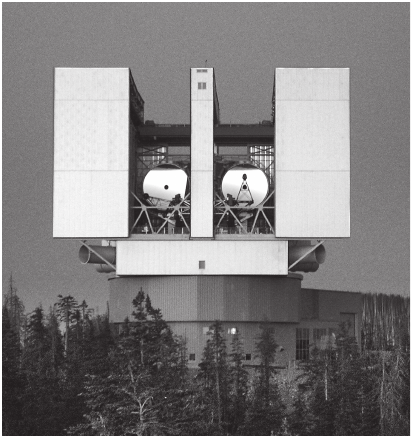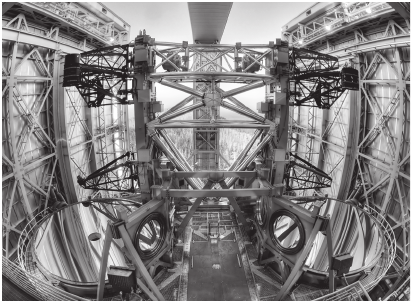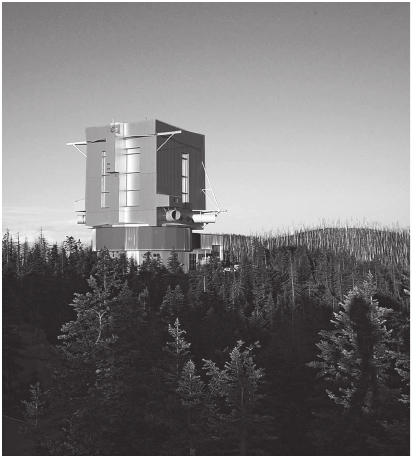Mount Graham International Observatory
Safford, Arizona
The Most Powerful Ground-Based Telescope in the World
The most isolated major observatory in Arizona can be found in the southeastern part of the state on rugged Mount Graham near Safford, where an eclectic trio of telescopes sits amid a heavily wooded wilderness at the end of one of the more imposing observatory access roads in North America.
Mount Graham International Observatory began life in 1984 with an act of Congress that designated 3,500 acres for an astronomical observatory and another 62,000 acres as a wilderness study area. Located at a steep elevation of 10,720 feet, Mount Graham reaches into heights where the light-blocking effects of water vapor in Earth’s atmosphere become much less of a problem, because there isn’t much vapor above the telescope, at least on most days.
| Web site | Address |
| www.eac.edu/discoverypark/mgio.shtm | Visitor access via: Eastern Arizona College Discovery |
| Phone (928) 428-6260 |
Park Campus 1651 West Discovery Park Boulevard Safford AZ 85546 |
| E-mail discoverypark@eac.edu |
However, the choice of this location triggered a classic environmental and social clash between the University of Arizona and its scientific partners versus the San Carlos Apache Tribe (advocating their sacred claims to the mountain) and a coalition of environmentalists concerned that the construction of the observatory amid the spruce-fir forest would lead to the demise of the Mount Graham red squirrel. This endangered member of the rodent family is known for its fluffy tail and lack of vocalization—characteristics likely due to their evolutionary isolation from their low-altitude brethren.
The opponents filed some forty lawsuits, eight of which reached a federal appeals court, before another act of Congress pushed the project forward. (The red squirrel population survived the construction of the telescope, as well as major fires in 1996 and 2004, and seems to be hovering near its early 1990s population of 200–250.)
After decades of anticipation, the mammoth Large Binocular Telescope (LBT), the undisputed centerpiece of Mount Graham, is ready to assume its place as the largest operational telescope in observatory-rich Arizona. When the combined size of both of its 8.4-meter (27.6-foot) mirrors on a single mount is factored into the equation, the LBT is the world’s largest ground-based telescope, equivalent in light-gathering ability to a telescope with a single 11.8-meter (38.7-foot) primary mirror, a bit larger than other contenders in the Canary Islands and on top of Mauna Kea in Hawaii.
The LBT has a moving weight of 600 tons, hung from two 46-foot-wide, C-shaped main bearings. This red-painted behemoth is surrounded by a 2,000-ton rectangular enclosure that is sixteen stories tall, its boxy exterior marked by several odd-looking air exhaust and ingestion tubes.
The LBT was conceived as a pathfinder in several ways, from its double set of mirrors to a suite of instruments permanently mounted at a variety of different focal points. These instruments are available to be switched into the beam of starlight much more quickly than on most other telescopes.
Beyond the light-gathering sensitivity of its two mirrors operating in a parallel observing mode, the fact that the two LBT mirrors are separated from center to center by a distance of 47 feet gives astronomers the ability to coherently combine the incoming light from the two giant “light buckets” with great precision—an observing mode known as interferometry (see pages 78–79). Used primarily to resolve fine details in the structures of planetary disks and galaxies, and to separate individual stellar point sources in densely crowded clusters, this technique enables the LBT to achieve a resolution equivalent to a telescope with a 23-meter (75.5-foot) primary mirror—nearly as large as the largest future ground-based telescopes being imagined today.

Exterior of the Large Binocular Telescope with shutters open.
Among many possibilities, this “binocular” capability may enable the LBT to take actual images of extrasolar planets, which until now have been observed by the secondary effects they cause on their parent stars (using their gravity to tug the star back and forth slightly during their orbits or blocking the star’s light by a tiny fraction when passing in front of them), and to resolve the disks of gas and dust from which planets form early in the lifetimes of their parent stars.

Interior of the Large Binocular Telescope.
The LBT is an international partnership between the University of Arizona’s Steward Observatory and the countries of Italy and Germany (25 percent each), along with Ohio State University and a number of other universities that each purchased a modest share of LBT. The project, which began essentially in 1989, has cost a total of $150 million. A less-than-ideal funding profile over the years and a major political and environmental fight over the site during the 1990s stretched the project out, painfully at times.
The mirrors are the product of an international collaboration as well, made from Florida sand that was turned into 40 tons of glass in Japan and then formed into polished 18-ton mirrors in the University of Arizona mirror lab. The mirrors made the tortuous three-day truck trip up the mountain at 1 mph in 2002 and 2005, respectively. One unique feature of the mirrors (and their mounts) is that they are designed to have their reflective surfaces recoated with a thin aluminum film (to restore high reflectivity) while they are in place, rather than being moved to a separate chamber in an inherently dicey maneuver that is one of the least-welcomed maintenance tasks for any large telescope.
The LBT is also unique in that it has taken on the challenge of making its large (0.9-meter or 36-inch) secondary mirrors flexible so they can compensate for distortions in image quality wrought by turbulence in Earth’s atmosphere; it does this by using a technique known as adaptive optics (see page 10). Because of the Gregorian design of the LBT, these complicated mirrors are concave (curved inward) rather than the much more common convex design. Only 1.6 millimeters (0.06 inch) thick, each mirror is backed by 672 small piezoelectric magnets that can push or pull on the surface one thousand times per second when subjected to electrical signals emanating from a device known as a wavefront sensor, which monitors in near real time the ongoing changes in image distortion caused by the atmosphere. The testing process for the mirrors included a historic tie back to George Ellery Hale, the famous founder of Mount Wilson and Palomar observatories: A venerable solar-observing tower at Arectri Observatory near Florence, Italy, built by Hale, was modified and used to test the LBT secondary mirrors.
Each large primary mirror of the LBT has a large 36-megapixel digital camera at its prime focus—one optimized for blue-tinted starlight and one optimized for red. The mirror with the blue camera above it saw first light in October 2005 and started its first major science observations in January 2007; the red camera opened for science in November 2007.
The first binocular observations by LBT were achieved in early 2008. Keeping the two cameras tightly aligned with each other is an amazing feat: Their positions must be controlled to a precision of 0.1 millimeter (0.004 inch) in order for light from the two telescopes to be combined coherently, a requirement for creating high-resolution, interferometric images. This must be done in the face of the variable “sagging” of the overall telescope structure (due to Earth’s gravity) by as much as 20 times that amount, as the massive telescope structure rotates from the zenith toward the horizon.
Early science results from LBT include detailed maps of the star types in nearby small galaxies and studies of a tiny dwarf galaxy with a very odd elongated shape, implying either that it is gravitationally distorted as a result of a trip through our Milky Way or that it suffered a very unusual birth early in the history of the Universe.
But it is studies of distant planets around other stars where the LBT is likely to make some of its major marks. A special planet-hunting instrument fed by optical fibers will sit in a temperature-controlled trailer at the base of the telescope. It aims to make such precise measurements of the gravitational tugs of planets on their parent stars that the support trailer is outfitted with supersensitive accelerometers capable of measuring tiny conflicting signals such as the force of ocean waves hitting the distant coast of California, more than 500 miles away.
Mount Graham is also home to two other somewhat unusual astronomy facilities. The Vatican is not the first place that many people would associate with ongoing scientific study of astronomy. However, the Vatican has a long history of supporting (and fighting with) astronomy stretching back four hundred years, to the first use of the telescope for astronomy by Galileo Galilei.
The Vatican has supported astronomical research at sites ranging from Rome to the pope’s summer residence south of the city in Castel Gandolfo—and to the arid peak of Mount Graham in Arizona’s Pinaleño Mountains.
Dedicated in September 1993, the Vatican Advanced Technology Telescope (VATT) was the first optical-infrared telescope on the mountain. The 1.8-meter (71-inch) primary mirror for the VATT was an early landmark accomplishment by the University of Arizona mirror laboratory, in its first attempt at spin-casting a mirror over ceramic molds inside a rotating furnace.
Asked often about the apparent conflict between religion and the quest for scientific knowledge, VATT directors characterize their purpose as fostering a “respectful dialogue” about the respective roles of the two in our lives. As such, the research carried out with the VATT is similar to the high-quality work with modest-sized telescopes around the world, ranging from studies of galaxy evolution to the properties of asteroids.

Exterior of the LBT.
The other major facility on Mount Graham also has some international roots. The Arizona Radio Observatory SubMillimeter Telescope (SMT) is a University of Arizona facility run by its Steward Observatory staff. But it originated as a cooperative project between Steward Observatory and the Max-Planck-Institut für Radioastronomie in Bonn, Germany, and it began life as the Heinrich Hertz Telescope. Designed to probe the same type of energetic radiation that most people know from their kitchen microwaves, the SMT is equipped with some instruments that are similar to those found on optical-infrared telescopes, while others are more analogous to those found on radio telescopes. It has a large 10-meter-wide (33-foot-wide) dish like a radio telescope but is housed in an enclosure more similar to those sheltering optical telescopes. The careful design of the composite-material structure that supports the main dish makes it the most accurate radio telescope ever built, according to the project staff; it has a 12-meter (39-foot) radio observatory “cousin” operated by the University of Arizona on Kitt Peak.
The microwave part of the electromagnetic spectrum is ideal for observing features as diverse as the chemistry of interstellar clouds that could give birth to stars to the remnants of radiation at the edge of the observable Universe, which marks the beginning of the cosmos as we know it, just 400,000 years after the Big Bang.
The telescopes on Mount Graham have survived both a period of mostly unwelcome notoriety and intense forest fires to reach a point where they are poised to deliver unexpected discoveries of all types.
For the Public
The official tour agent for Mount Graham International Observatory is a mixed-use science center, nature preserve, and conference facility known as Discovery Park, now operated by Eastern Arizona College. It is located in the small town of Safford, at the intersection of Routes 70 and 191 in southeastern Arizona. Most visitors will find themselves accessing 191 from Interstate 10, a 33-mile drive to the south.
Public tours of Mount Graham Observatory are conducted by advance reservation, beginning about mid-May through mid-November, weather permitting. Be aware—the 40-mile trip up a hilly and curving road to the summit and back is not for the fainthearted, and it requires a full-day commitment.
The observatory tours begin with a 9:00 A.M. arrival time at Discovery Park and an orientation briefing on the history and ecology of the mountain. The tour van leaves Discovery Park for Mount Graham Observatory at 9:30 A.M. and returns at approximately 4:30 P.M. The $40-per-person ticket price includes a sack lunch at the U.S. Forest Service’s Columbine Visitor Center. Among the supplies recommended at the Discovery Park Web site (www.eac.edu/discoverypark/mgio.shtm) are sunscreen, water, aspirin, and (if needed) Dramamine.
Tours require a minimum of six people, and advance notice of two weeks or more is preferred. Because of the high altitude (10,720 feet), the tour is not recommended for people with heart conditions or respiratory problems, and children must be at least eight years old. To make reservations or for further information, call (928) 428-6260 or e-mail discoverypark@eac.edu.
Discovery Park in Safford also is home to a 20-inch (0.5-meter) telescope in its Gov Aker Observatory, a virtual-reality space shuttle ride through the solar system, a replica of an 1860s steam locomotive, a variety of nature trails, and one of the world’s largest camera obscuras. The Discovery Park campus is free to the public Monday through Friday, 9:00 A.M. to 5:00 P.M., and Saturday evenings from 4:00 P.M. to 10:00 P.M.
For Teachers and Students
No-cost tours and guided science field trips are available to schools in the surrounding area. Boy Scout troops and Cub Scout packs are also encouraged to visit for special tours and for meetings using the surrounding nature habitat.
And More: Mount Lemmon SkyCenter
In addition to Mount Graham and several telescopes on Kitt Peak, the University of Arizona operates a significant observatory on Mount Lemmon, about 45 miles northeast of its Tucson campus in the Santa Catalina Mountains. The observatory was a radar base of the U.S. Air Defense Command until 1970, and it now hosts two 1.5-meter (60-inch) telescopes, plus a 1-meter (40-inch) telescope operated by the Korean Astronomy Observatory, as well as several smaller telescopes, at a relatively high altitude of 9,157 feet.
The telescopes on Mount Lemmon were pioneers in the field of infrared astronomy and—in partnership with a 1.5-meter (60-inch) telescope on nearby Mount Bigelow—continue a landmark search for nearby asteroids known as the Catalina Sky Survey.
Known in recent years for intensive astronomy camps for students, advanced amateurs, and Scouts, the facilities on Mount Lemmon are now part of a larger university effort called the Mount Lemmon SkyCenter, which includes “Discovery Days,” summer camps, and other programs linked both to astronomy and to environmental themes, such as the university’s world-class tree-ring science department and the greenhouse-like Biosphere 2 facility north of Tucson.
Since May 2008, the astronomy operations include a new nighttime public observing program on Mount Lemmon using a loaned 0.6-meter (24-inch) telescope; the SkyCenter hopes to replace this with a 0.8-meter (32-inch) or larger, which promises to be among the largest in the world available for regular public viewing. The cost is $48 per person for the evening program, with higher fees for an overnight experience. Call (520) 626-8122 for more information or go to skycenter.arizona.edu.